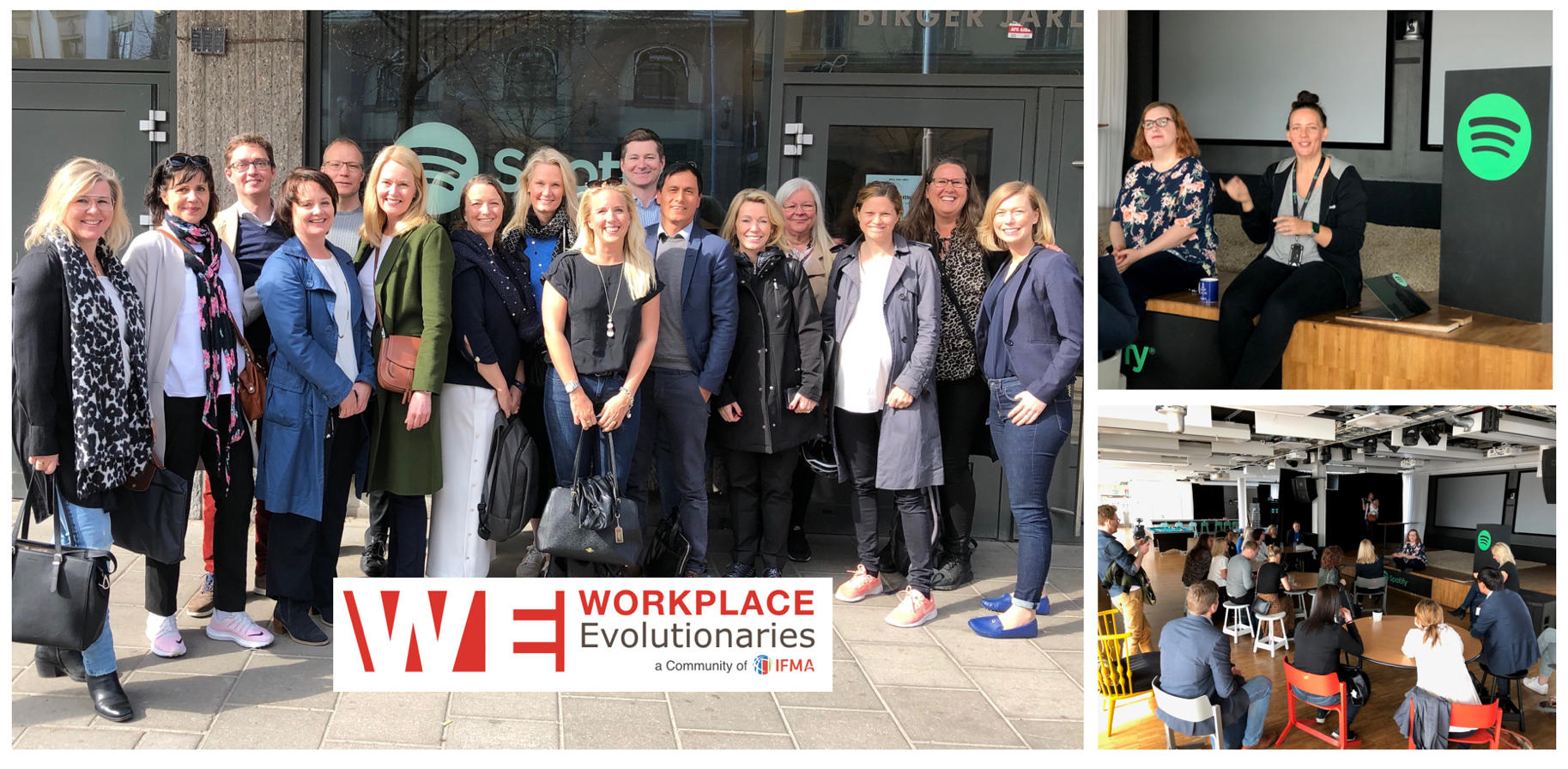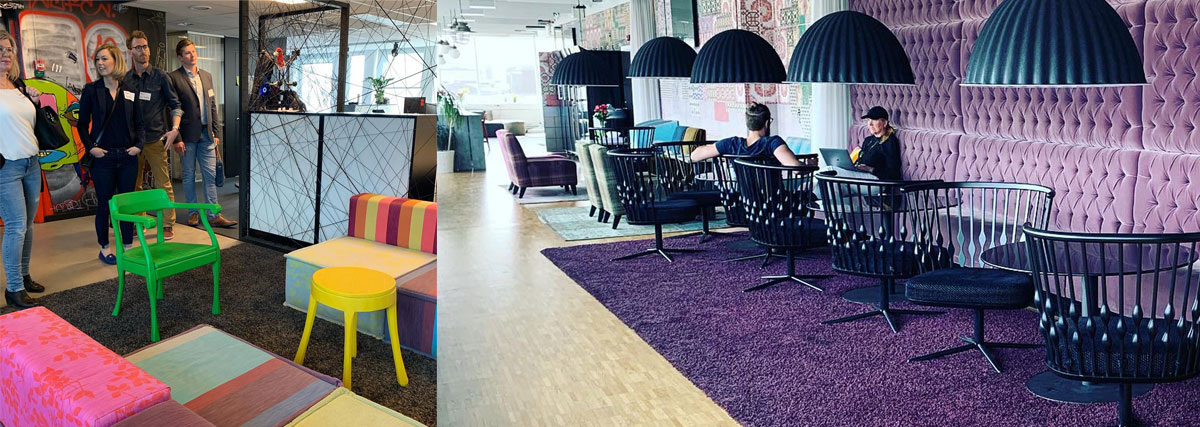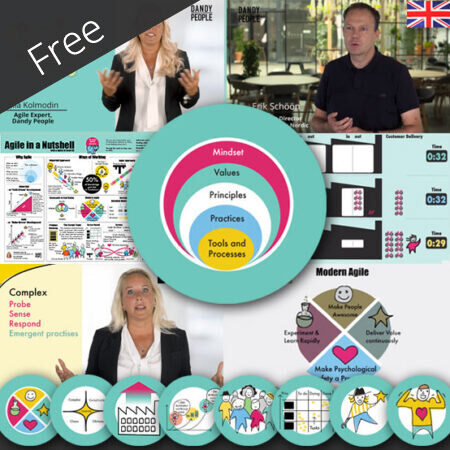A few weeks ago me and Frida Mangen did a talk on Activity Based Seating for Agile teams for the WE network, Workplace Evolutionaries. Afterwards we invited them for a visit to the old Spotify BJG RnD office to experience and learn more about the mindset of Agile organizations and how the interiors can support high performance teams and aligned autonomy.
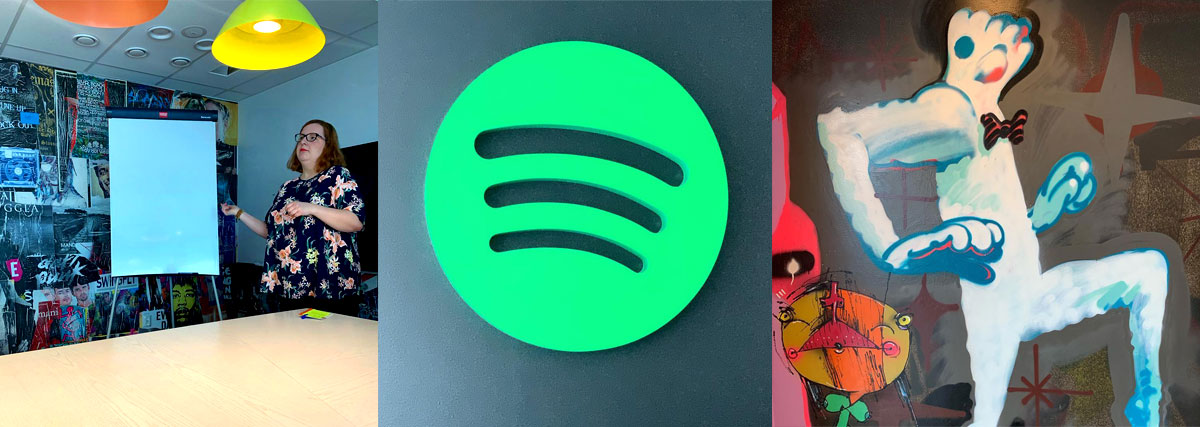
The group visiting Spotify consisted of office interior experts off different kinds, designers, architects, scientist and change makers. We met up outside the office at Birgerjarlsgatan. We were warmly welcomed by Zuza Majkowska who was acting as our guide for the tour, and at the end of the tour also Becca who is a team engeneering manager and part of the renovation committee also joins and tells us more about the teams perspective and their work with the ongoing renovation.
This post is mostly a transcription of these conversations during the viewing.
The Spotify building consists of 11 floors, and Spotify are renting all floors but one. The tour started in a common space in one of the few big meeting rooms where the group of 22 ppl squeezed in to learn more about Spotify first before viewing the space.
Striving for aligned autonomy in everything – also in the office space
Zuza: We are always striving for aligned autonomy at Spotify in everything they do, also in the space of our office.
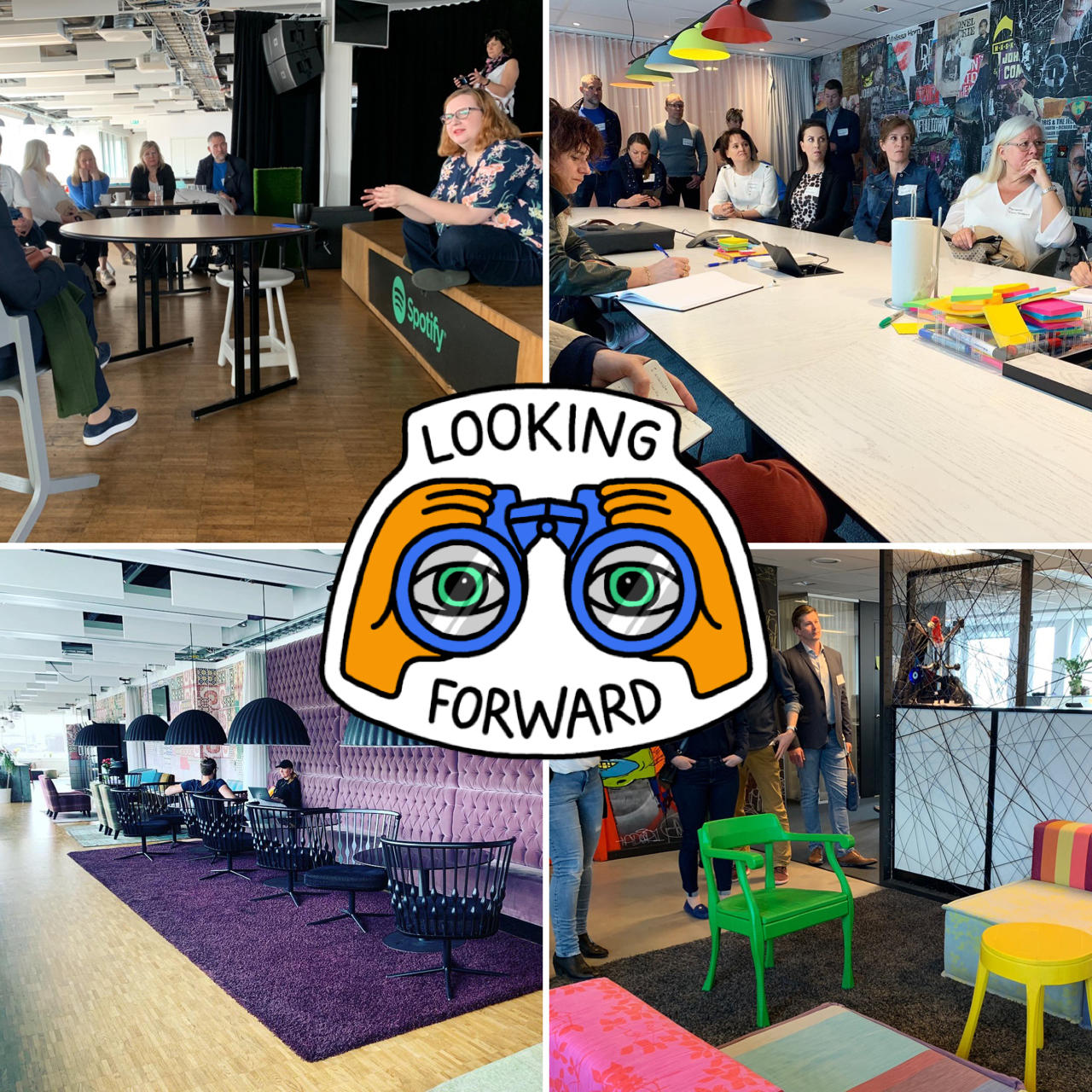
She continues to explain a bit how Spotify is organized. Our organization is made up of teams and they are called squads. A business unit is a collection of tribes and a tribe is a collection of squads. In this building we are one business unit and we will have 40 squads and 4 tribes. We try to keep dependencies within the tribe, but sometimes it’s not possible. They might need to work with other tribes too. If a team from Stockholm need to work with a squad in NY, they would probably travel there to make the collaboration as smooth as possible. But it’s totally up to them, we have no rules for that.
We definitely don’t have any rules or policies of how to behave in our space. We want everyone to be able to feel comfortable and be themselves
All squads are like a small company, they have all their people in one space, developers, designers, Agile coaches and their manager. All squad spaces have meeting room, a lounge area to sit and talk or lie down to relax in and of course desks for everyone.
The only ceremony that all squads are doing that Zuza knows of is standups, and the want to be able to do it as close to their desks as possible. But other then that all teams have different needs and need the spaces to support those. Also most teams are doing mob- and pair-programming, which also needs to be done in their teams.
We never ask teams to do standups in meeting rooms or away from their team space because thats very inefficient and keeping it all visual on the walls close to the team helps them to have valuable structured dialogues at any time – not just at standup
Squads like to “nest” in their space and build identity
Zuza: A squad should be able to change how they work, and also their space, otherwise they can’t be autonomous, nor aligned. They should have the freedom and flexibility to change over time too to enable improvements.
Becca: Our squads really want to ”nest”. They want to build their identity in their space. We can go and grab what we want in the office, like a spare sofa or something thats already in the house. In our team we have a lot of plats and thats because we had a lot of plats in the office from an event and we wanted to have them and take care of them in our squad.
The upcoming renovation of the BJG office
The reference committee with team members interact directly with the architects to find the best solutions together.
Zuza: Some changes will be made in the new space and the biggest one is that teams will be sitting close to the windows to get more light, not as it is now where the windows are in the corridor and the teams are placed along the wall. Even though there are only string “walls” in between the windows and the team space it gets very dark in the back where a lot of people are sitting.
Becca: The architects had first shielded the teams too much, and we felt we really need to connect more with the other teams. So we asked the architects to add more collaborative open spaces for teams to collaborate and brainstorm and leave stuff in, full with whiteboards, screens and other visualization tools.
Walls covered in whiteboards, sofas and meeting rooms within the squad area
Becca: The teams have a lot of metrics and data that they are monitoring, and right now they don’t have enough screens to visualize that. They are also missing whiteboards, even though most walls are full whiteboards of different kinds.
Walking around in the office the architects comment on that there are A LOT of whiteboards… and it is. They have beautiful whiteboards in different colours, pink and green as well as white. Almost all walls have whiteboard “wallpaper” on them, and they also have whiteboards on wheels that have thick soft material on the back for improving decreasing the sound.
Zuza: What we will keep is that all squads will have their own meeting rooms, and even more than before, they will have rooms for 2 people, 4 people and a bigger one for workshops and bigger meetings where they can always keep all their work on the walls. Between the squads there will be a shared sofa area and more flexibility to scale up and down their teams. Today all teams have their own sofa area, so this is probably something they will miss a bit.
We will keep our desks big enough so that you can fit two people working side by side to facilitate pair work as easily as possible, and also you can elevate them for sitting or standing.
What limits us in how many people we have on each floor is mostly the ventilation. But it’s always the teams ability to do their work in the team as well as togehter with other teams that gives the direction.
We won’t have that much need for big meeting rooms. Teams usually use 10 ppl meet rooms once a day and for bigger meetings we have open spaces whit a scene where we can facilitate most type of big meetings such as workshops, big demos, get togethers and even live music in the same space.
There is only one rule at Spotify when it comes to the space
- Every employee should have their own desk
People are very attached to their desks. Especially the developers that have several screens.
The space might look pretty chaotic, but we want everyone to be able to put up their work on the walls so that everyone get to see what others are doing. It should be inviting to do that and you should never get punished for showing your work.
Zuza: My favourite space is the squad space where the whole squad can sit and do all their work in a very focused and creative way. One of the pieces in the puzzle enabling that is that they they never need to book meeting rooms. The squad space is totally optimized for teamwork and to collaboration between teams. In the other spaces where we don’t have these squad spaces we have fights over meeting rooms.
We also have specific space for learning that are a lot more flexible than ordinary meeting rooms. They are optimized for different type of learning situations. We have some small spaces where we can sit by ourself, but we are willing to sacrifice that for spaces that enable collaboration. If you hear people talking around you, you are much more likely to work together. We always have free desks in a separate space where people from other offices can come and join.
Some companies have clean desk policies – how do you do you handle it?
Becca: We don’t have a clean desk policy, but don’t leave valuables for your own safety. We have full time cleaning staff here. They are really nice but they don’t touch our stuff on our desks. We have had some problems with security. So we had to increase security a bit. People from outside had come in to the office to steal laptops without stickers. Now we have big safe where we can put our computers and test devices. We also have a smaller safe in the squad. You can get a locker too if you like.
People usually never help to put in the dishwasher. In some offices they clean the desks once a week, but we don’t like that. If it becomes too sloppy the teammates fix it for you and handle it in the long run so it doesn’t create conflicts.
The squads view of their space
Becca: All developers are sitting close together in our squad spaces which is great and as a manager I too can be in the same space. With the seating we have the developers who have to focus a lot have their own kind of shield space at their desk, but they can still be in contact with everyone around you. The sofa area is also really nice, we have a TV screen with hangout and can call in anytime, its only accessible by the team. Also we have whiteboards at the sofa space and where we sit. If people are sitting in the sofas and discuss anyone can go there and participate in the discussion if we like and come with ideas or information.
Right now we are two squads in the same squad area, but that is very disturbing when they in the other team are getting excited about something, that gets disturbing for others because we work on different problems and focuses.
Does the team use digital or physical boards?
Becca: We have tried digital whiteboards, but it hasn’t been that successful. If we have remote people we solve it in the team how we want to do it. In our team we just post photos of the board. It’s very manual, but we think it works better. Another team uses Jira and hangout, and only do digital board. It’s all up to the team. But its surprisingly gratifying to move things physically and also great that you can view it at all times.
Quite contradictory to what you might think, most of my engineers want a solution thats quick and easy to use, they don’t care if it is hi-tech and cool. They just want it to work. Jira is too slow they think, stickies and whiteboards are much quicker. Also the want the information quick easy access at al times to help them in their work.
How does the team meet with their stakeholders?
Becca: We work with OKSs and a missions for each teams, which gives us a great way to understand ourself what to work on to reach our goals, so our stakeholders are mostly other teams. To collaborate with other teams we just bring the teams involved together. We also work a lot with embedding people in teams to spread knowledge and remove knowledge silos.
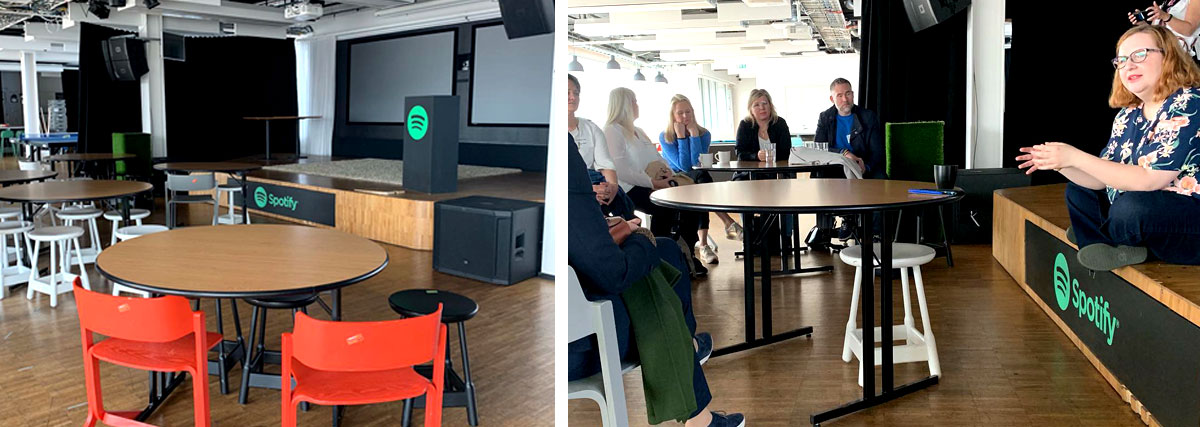
We also meet with ”normal stakeholders” and then we meet with them in our meeting room in the squad space mostly to collaborate and visualize. Our walls in the meeting rooms are full of those kind of visualizations.
Are there only young people at Spotify?
Becca: The medium age is 34 at Spotify right now. But we actually have people with grey hair *laughter*. We really want diversity and inclusion and do polls on that regularly. The last time I did the poll I got to check in that I’m above 40, so I’m in one of the minority groups now.
In this series of blog posts around interior for Agile teams you also find:
– Free Infographic
– The Free Report on the impact of Activity based seating
– Free PP slides of the report
– 10 design principles for Agile offices inspired bu Spotify
